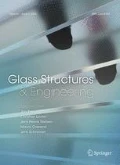Glass is all around us, has been so for many years and will continue to be for years to come. Most people associate glass with windows and facades. However, a perception of glass as a resistant and load carrying material used for structural key elements seems to be increasingly present in the engineering society. Considering the publications and conferences over the last couple of years, the number of universities and especially young researchers involved in the field of glass research for the built environment seems to be increasing as well. All of which makes it an even more important task for all of us working in the field, whether it is engineering, academia, research, development, production or design of glass to communicate our findings and experiences for the benefit of our society.
Glass Structures & Engineering is an international platform for doing this and we are proud to give you the first journal issue of 2019, our fourth year for the journal.
The previous years have been successful and the journal is now also indexed by SCOPUS. Furthermore, we have decided to change the graphics of the cover for each issue and to increase the number of issues per year from two to three and to increase the yearly number of pages with approximately 80%. This has only been possible due to the continuous support from you, the glass engineering society.
For the present issue we have selected nine papers that went through a double blind review process as usual. The first paper is an interesting case study of the museum “La Maison de Fondateurs” in Le Brassus, Switzerland, providing a valuable view into the inspiring work associated with the engineering design process (Villiger et al. 2018). The second paper of this issue presents a case study on revolving entrance doors (Haese 2018). The use of curved glass in the building envelope is becoming increasingly common, however, the stiffness of curved elements is much higher than for flat elements and the usual design rules might not apply anymore. The paper by Bao and Gregson (2018) presents a parametric investigation of the load-sharing behaviour of curved IGU’s along with a simple iterative numerical strategy applicable for almost any finite element code. In the paper by Silvestru et al. (2018), we find a thorough experimental investigation into the linear adhesive connections for linearly supported laminated glass. Our next paper concerns a numerical study on the mechanical behavior of insulating glass units adhesively connected to a wooden frame, a hybrid structure, with the title: “On parameters affecting the racking stiffness of timber-glass walls”, (Ber et al. 2018). In the search for ductile and transparent structural elements such as beams, glass has previously been reinforced with ductile materials such as steel, forming another hybrid structure with the aim of improving the post-failure performance. The paper by Engelmann and Weller (2018) investigates the effect of post-tensioning the reinforcements of such laminated glass beams. Alignment of laminated glass can sometimes pose an offset between the plies, which can be challenging from an aesthetic point of view, but also when loads are introduced. After lamination edges can be re-grinded to remove the offset, however, in thermally tempered glass this might affect the residual stress state. The paper by Lohr and Weller (2018) experimentally evaluates the influence on the residual stresses after grinding. One of the challenges for thermally tempered glass is to control the generated residual stresses more accurately. The paper by Pourmoghaddam and Schneider (2018) is providing a rarely seen experimental study relating varying cooling rates with the residual stress state.
Glass is made from raw materials, which are relatively inexpensive and exists as a large natural resource. Using glass bricks in masonry walls to a greater extent could be the future. The last paper in this issue by Fíla et al. (2018), presents an experimental investigation of the mechanical properties of the mortar used for glass bricks.
From the interesting papers given to you in this issue, it is clear that glass is all around us and the development for the years to come will be interesting to follow. Enjoy reading!
References
Bao, M., Gregson, S.: Sensitivity study on climate induced internal pressure within cylindrical curved IGUs. Glass Struct. Eng. (2018). https://doi.org/10.1007/s40940-018-0082-9
Ber, B., Finžgar, G., Premrov, M., Štrukelj, A.: On parameters affecting the racking stiffness of timber-glass walls. Glass Struct. Eng. (2018). https://doi.org/10.1007/s40940-018-0086-5
Engelmann, M., Weller, B.: Residual load-bearing capacity of spannglass-beams: effect of post-tensioned reinforcement. Glass Struct. Eng. (2018). https://doi.org/10.1007/s40940-018-0079-4
Fíla, J., Eliášová, M., Sokol, Z.: Experimental investigation of mortar mechanical properties for glass brick masonry. Glass Struct. Eng. (2018). https://doi.org/10.1007/s40940-018-0085-6
Haese, A.: Revolving entrance doors: Machines or structural elements? Glass Struct. Eng. (2018). https://doi.org/10.1007/s40940-018-0081-x
Lohr, K., Weller, B.: Residual stress distribution in tempered glass with reground edges. Glass Struct. Eng. (2018). https://doi.org/10.1007/s40940-018-0084-7
Pourmoghaddam, N., Schneider, J.: Determination of the engine power for quenching of glass by forced convection: simplified model and experimental validation of residual stress levels. Glass Struct. Eng. (2018). https://doi.org/10.1007/s40940-018-0078-5
Silvestru, V.A., Englhardt, O., Schneider, J.: Linear adhesive connections at the edge of laminated glass panes: an experimental study under tensile, compressive and shear loading. Glass Struct. Eng. (2018). https://doi.org/10.1007/s40940-018-0080-y
Villiger, J., Willareth, P., Doebbel, F., Nardini, V.: Interlocking glass spiral as building structure of the watch museum “La Maison des Fondateurs”. Glass Struct. Eng. (2018). https://doi.org/10.1007/s40940-018-0077-6
Author information
Authors and Affiliations
Corresponding author
Additional information
Publisher's Note
Springer Nature remains neutral with regard to jurisdictional claims in published maps and institutional affiliations.
Rights and permissions
About this article
Cite this article
Nielsen, J.H., Belis, J., Louter, C. et al. Glass is all around us!. Glass Struct Eng 4, 1–2 (2019). https://doi.org/10.1007/s40940-018-00094-y
Published:
Issue Date:
DOI: https://doi.org/10.1007/s40940-018-00094-y

